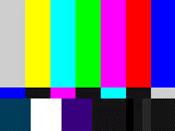"Eyeballing" Monitor
Setup
(AKA, Eight simple steps to setting
up a color video monitor.)
Often, you need to set up a video
monitor to make sure video is being correctly displayed.
To do this you need to have a SMPTE color bar feed, such  as the one shown here, and a monitor with switches for the red, blue, and green signals (they are often behind a little door), plus controls for chroma, hue, color/monochrome, brightness, and contrast. Professional color monitors should have all of these controls. as the one shown here, and a monitor with switches for the red, blue, and green signals (they are often behind a little door), plus controls for chroma, hue, color/monochrome, brightness, and contrast. Professional color monitors should have all of these controls. Note, that is not "color by committee";'people see color in different ways. Only one person (with good color vision) should be involved — and that person should not stare at the monitor for more than a few minutes. Recall that the eye tends to adapt to problems in color balance, so it may be necessary to leave the area for a few minutes and then return. 1. First, switch off the red and green colors. You should now see four vertical blue bars separated by three darker bars. At the bottom of each blue bar will be a small rectangular area. 2. By adjusting the hue and chroma controls, you should be able to make each of the four vertical blue bars match the small area below it. (The hue control affects mainly the middle two bars, and the chroma affects mainly the two outside bars.) Keep working with these two controls until you get the best match possible. 3. Switch the red, blue, and green colors back on 4. Note that below the red (sixth) bar on the screen there are three narrow vertical gray bars. If you don't see them, adjust the brightness control until these bars can be clearly seen. 5. Switch the color/monochrome switch to monochrome. 6. Reduce the brightness control until center gray bar just disappears from the screen. 7. Adjust the contrast control until the white reference square at the lower left of the screen is bright enough to appear white, but not so much that it causes adjacent areas to "glow." Since the brightness and contrast controls interact, you will probably have to play with both of these until you get the desired effect. 8. Switch the color/monochrome switch back to color. The monitor is now set up and can be used to judge the chroma and luminance of displayed video.
|  as the one shown here, and a monitor with switches for the red, blue, and green signals (they are often behind a little door), plus controls for chroma, hue, color/monochrome, brightness, and contrast. Professional color monitors should have all of these controls.
as the one shown here, and a monitor with switches for the red, blue, and green signals (they are often behind a little door), plus controls for chroma, hue, color/monochrome, brightness, and contrast. Professional color monitors should have all of these controls.